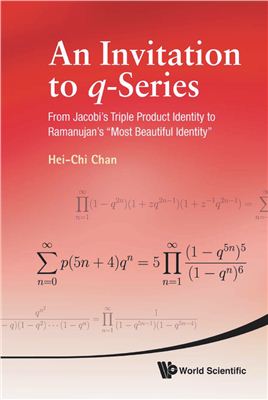World Scientific Publishing Company, 2011. - 236 pages.
Цель данных лекций - представление самодостаточного изложения
некоторых замечательных формул, открытых С. Рамануджаном(гениальным
индийским математиком, наиболее известным благодаря своим работам в
области теории чисел).
В данных лекциях в основном рассматриваются результаты по непрерывным дробям Роджерса-Рамануджана и по "Most Beautiful Identity" (рус. дословно: "самое красивое тождество") Рамануджана. The aim of this lecture notes is to provide a self-contained exposition of several fascinating formulas discovered by Srinivasa Ramanujan. Two central results in these notes are: the evaluation of the Rogers-Ramanujan continued fraction - a result that convinced G.H. Hardy that Ramanujan was a mathematician of the 'highest class', and what G.H. Hardy called Ramanujan's 'Most Beautiful Identity'. This book covers a range of related results, such as several proofs of the famous Rogers-Ramanujan identities and a detailed account of Ramanujan's congruences. It also covers a range of techniques in q-series. Contents: Prefrace
Introduction Jacobi's Triple Product Identity Fitst proof(via fucntional equation)
Second proof(via Gaussian polynomials and the q-binomial theorem)
Some applications
The Boson-Fermion correspondence
Macdonald's identities The Rogers-Ramanujan Identities Fitst proof(via fucntional equation)
Second proof(involving Gaussian polynomials and difference equations)
Third proof(via Bailey's lemma)
Excursus: Mock theta functions The Rogers-Ramanujan Continued Fractions A list of theorems to be proven
The evaluation of the Rogers-Ramanujan continued fractions
A "difficult and deep" identity
A remarkable identity from the Lost Notebook and cranks
A differential equation for the Rogers-Ramanujan continued fraction From the "Most Beautiful Identity" to Ramanujan's congruences Proofs of the "Most Beautiful Identity"
Ramanujan's congruences I: analytical methods
Ramanujan's congruences II: an introduction to t-cores
Ramanujan's congruences III: more congruences
Excursus: modular forms and more congruences for the partition function Appendix A. Proofs on nu(-1/tau) = sqrt(-i*tau)*nu(tau)
Appendix B. The ranks of the partitions of n=9
Appendix C. The cranks of the partitions of n=9 Bibliography
Index
В данных лекциях в основном рассматриваются результаты по непрерывным дробям Роджерса-Рамануджана и по "Most Beautiful Identity" (рус. дословно: "самое красивое тождество") Рамануджана. The aim of this lecture notes is to provide a self-contained exposition of several fascinating formulas discovered by Srinivasa Ramanujan. Two central results in these notes are: the evaluation of the Rogers-Ramanujan continued fraction - a result that convinced G.H. Hardy that Ramanujan was a mathematician of the 'highest class', and what G.H. Hardy called Ramanujan's 'Most Beautiful Identity'. This book covers a range of related results, such as several proofs of the famous Rogers-Ramanujan identities and a detailed account of Ramanujan's congruences. It also covers a range of techniques in q-series. Contents: Prefrace
Introduction Jacobi's Triple Product Identity Fitst proof(via fucntional equation)
Second proof(via Gaussian polynomials and the q-binomial theorem)
Some applications
The Boson-Fermion correspondence
Macdonald's identities The Rogers-Ramanujan Identities Fitst proof(via fucntional equation)
Second proof(involving Gaussian polynomials and difference equations)
Third proof(via Bailey's lemma)
Excursus: Mock theta functions The Rogers-Ramanujan Continued Fractions A list of theorems to be proven
The evaluation of the Rogers-Ramanujan continued fractions
A "difficult and deep" identity
A remarkable identity from the Lost Notebook and cranks
A differential equation for the Rogers-Ramanujan continued fraction From the "Most Beautiful Identity" to Ramanujan's congruences Proofs of the "Most Beautiful Identity"
Ramanujan's congruences I: analytical methods
Ramanujan's congruences II: an introduction to t-cores
Ramanujan's congruences III: more congruences
Excursus: modular forms and more congruences for the partition function Appendix A. Proofs on nu(-1/tau) = sqrt(-i*tau)*nu(tau)
Appendix B. The ranks of the partitions of n=9
Appendix C. The cranks of the partitions of n=9 Bibliography
Index

